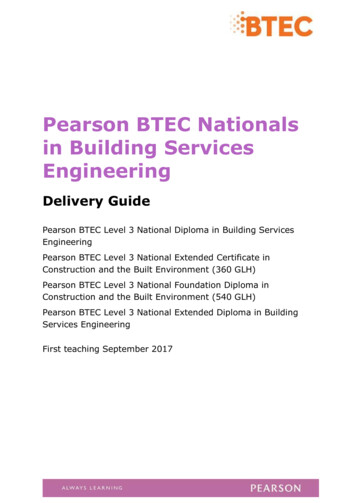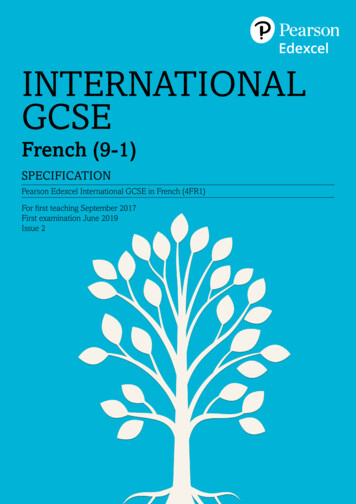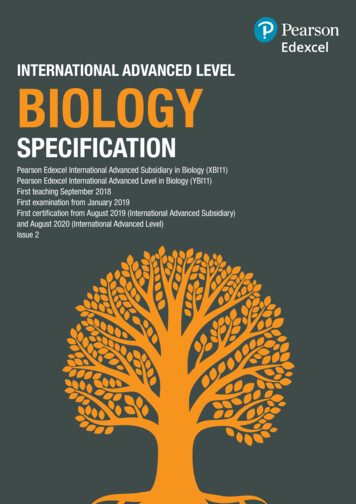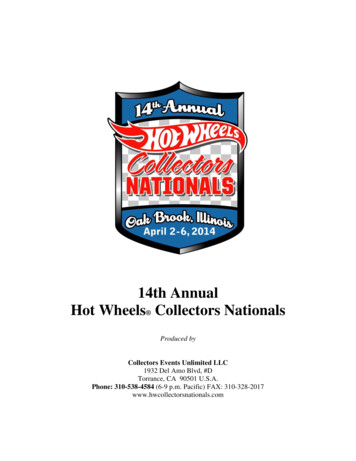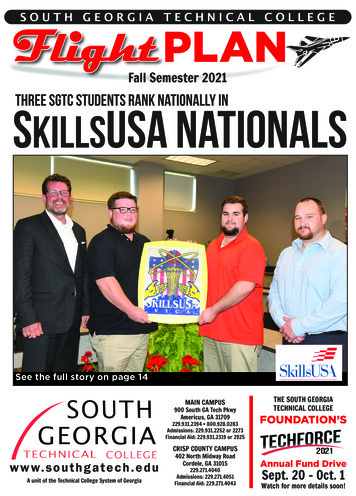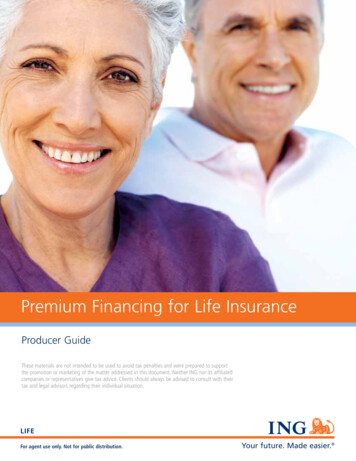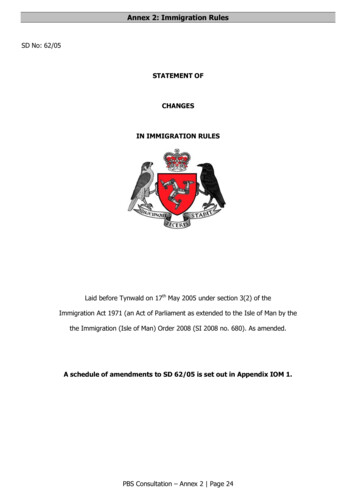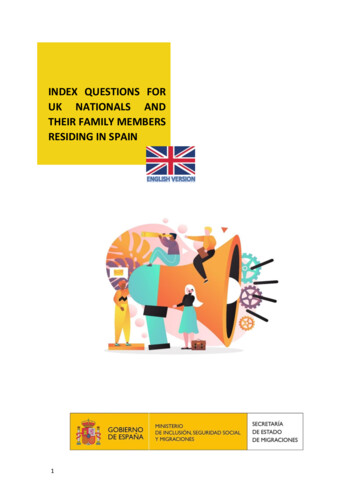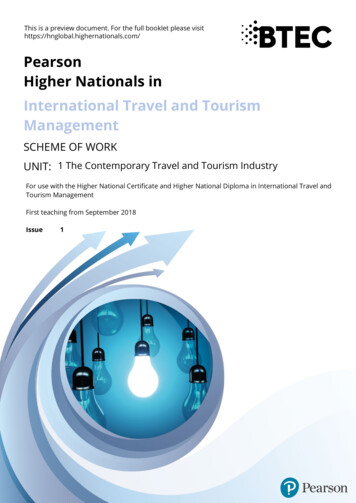
Transcription
This is a preview document. For the full booklet please igher Nationals inInternational Travel and TourismManagementSCHEME OF WORKUNIT: 1 The Contemporary Travel and Tourism IndustryFor use with the Higher National Certificate and Higher National Diploma in International Travel andTourism ManagementFirst teaching from September 2018Issue1
Edexcel, BTEC and LCCI qualificationsEdexcel, BTEC and LCCI qualifications are awarded by Pearson, the UK’s largest awarding body offering academicand vocational qualifications that are globally recognised and benchmarked. For further information, please visitour qualification websites at www.edexcel.com, www.btec.co.uk or www.lcci.org.uk. Alternatively, you can get intouch with us using the details on our contact us page at qualifications.pearson.com/contactusAbout PearsonPearson is the world’s leading learning company, with 40,000 employees in more than 70 countries working tohelp people of all ages to make measurable progress in their lives through learning. We put the student at thecentre of everything we do, because wherever learning flourishes, so do people. Find out more about how wecan help you and your students at qualifications.pearson.comReferences to third-party material made in this specification are made in good faith. We do not endorse, approveor accept responsibility for the content of materials, which may be subject to change, or any opinions expressedtherein. (Material may include textbooks, journals, magazines and other publications and websites.) Allinformation in this document is correct at time of publication. All the material in this publication is copyright Pearson Education Limited 2017
Please note that Schemes of Work are for guidance and support only.They can be customised and amended according to localised needs and requirements.All schemes of work can be adapted to suit specific establishment time frames in line with GLH delivery.Higher National Certificate/Diploma inInternational Travel and Tourism ManagementSCHEME OF WORKProgramme Title:Higher Nationals in International Travel andTourism ManagementLevel:Unit Title:The Contemporary Travel and TourismIndustryTutor:Unit Number:1Academic Year:Learning Outcomes (LO)Assessment 1Assessment 24Assessment 3Assessment 4LO1 Discuss the development of the traveland tourism industry and explain how itsdifferent elements combine to provide atourism experienceLO2 Explain the factors driving touristbehaviourLO3 Determine current patterns and keytrends in travel and tourismLO4 Investigate the factors affecting thecurrent levels of popularity of differentglobal destinationsHNC/HND International Travel and Tourism Management 3
Please note that Schemes of Work are for guidance and support only.They can be customised and amended according to localised needs and requirements.All schemes of work can be adapted to suit specific establishment time frames in line with GLH delivery.SessionsLearning Outcome(s)Session ActivitiesTopic(s): Unit introductionSession 1LO1 Introduction to the unit and the two assignmentsDefinitions of travel and tourism (inbound, outbound, domestic)Volume and value of travel and tourismSample activities: Group activity: Discuss different definitions of travel and tourism.Pair work: Research size, volume and value of the market.Q&A session on the unit and curriculum ahead.Topic(s): Development of the travel and tourism industry Session 2LO1Historical context of travel and tourismFactors underpinning the growth of the industryChallenges and issues facing the industrySample activities: Pair work: Research the origins, history and development/growth of thetravel and tourism.Group discussion activity: What factors have had most impact on thegrowth of the industry?Class discussion activity: What are the main challenges and issues facingthe industry?Topic(s): Structure of the travel and tourism industry (1) Different sectors making up the travel and tourism industryDifferences between public, private and voluntary sector organisationsSample activities:Session 3LO1 Brainstorm the different sectors of the travel and tourism industry. Individual research: Investigate different organisations selected frompublic, private and voluntary sectors and present findings on theirpurpose and roles.Discussion activity on growth sectors, e.g. events and destinationmanagement. HNC/HND International Travel and Tourism Management 4
Please note that Schemes of Work are for guidance and support only.They can be customised and amended according to localised needs and requirements.All schemes of work can be adapted to suit specific establishment time frames in line with GLH delivery.SessionsLearning Outcome(s)Session ActivitiesTopic(s): Structure of the travel and tourism industry (2) Inter-relationships between industry sectors, levels of integration and thedistribution chainSample activities:Session 4LO1 Brainstorm the chain of distribution and impacts of integration Individual research: investigate the levels of integration and therelationships between organisations within the chain.Discussion activity: The changing face of the travel and tourism industrydue to technology. Topic(s): The tourism experience Session 5LO1The experience economyStages of the tourism experienceSample activities: Brainstorm activity: Discuss the drivers of the experience economy. Individual research: Investigate the tourism experience and the stages oftourism experience.Individual research: Assess the stages of the tourism experience. Topic(s): Workshop: Assignment 1Sample activities:Session 6LO1 Tutor-led overview of assessment requirementsOpen Q&A activity to address general questions and concernsReview of academic requirements and submission formatIndividual and group research towards assignmentIndividual student queries and questions.Topic(s): Factors driving tourism behaviour (1) Session 7LO2 Consideration of tourism flows between generating regions anddestinationsPush and pull factorsSample activities: Q&A session on tourism flows and push and pull factorsPair work: Different tourism flows for a specific region and/or destinationQuiz to recap on learning points covered.HNC/HND International Travel and Tourism Management 5
Please note that Schemes of Work are for guidance and support only.They can be customised and amended according to localised needs and requirements.All schemes of work can be adapted to suit specific establishment time frames in line with GLH delivery.SessionsLearning Outcome(s)Session ActivitiesTopic(s): Factors driving tourism behaviour (2) Session 8LO2Personal determinants that influence tourist behaviourClassification of tourist characteristics (e.g. Kotler et al)Rationale and purpose for tourism visitsSample activities: Class activity: Discuss the classification of tourist characteristics.Group activity: Identify and discuss personal determinants that influencetourist behaviour and factors that drive rationale for tourism visits.Quiz to recap on learning points covered during sessions 7 and 8.Topic(s): Models of tourism motivation How different motivations influence tourist behavioursDifferent models of motivation and their applicationSample activities:Session 9LO2 Individual research: Investigate the motivations affecting the behavioursof different categories of tourist.Pair work: Explore and discuss the different models applicable to touristbehaviour.Presentation activity: Present (in pairs) on the strengths and weaknessesof a chosen model of tourist behaviour.Topic(s): Review of student progress on the first assignmentSample activities:Section 10LO1 Brief tutor-led overview of assessment requirements Open Q&A activity to address general questions and concerns Review of academic requirements and submission format Individual student queries and questions.Topic(s): Factors that inform consumer decision makingModels of consumer behaviour that reinforce the buying processSample activities:Session 11LO3 Group activity: Identify different models of consumer behaviour and theirimpact on the buying process.Pair work: Explore ways in which organisations can influence consumerbehaviour in the travel and tourism industry.Presentation activity: Present (in pairs) to class on strategies employed toinfluence consumer behaviour.HNC/HND International Travel and Tourism Management 6
Please note that Schemes of Work are for guidance and support only.They can be customised and amended according to localised needs and requirements.All schemes of work can be adapted to suit specific establishment time frames in line with GLH delivery.SessionsLearning Outcome(s)Session ActivitiesTopic(s): Session 12LO3Techniques for analysing and interpreting tourism patternsUse of quantitative and qualitative dataDrawing on primary and secondary data sourcesDrawing conclusions and reporting key findingsSample activities: Individual research: Explore the difference between quantitative andqualitative data sources and the uses and applications of each.Pair work: Discuss findings from individual explorations and agreeappropriate applications of different data sources.Prepare a short summary report on the application of data sources andmarket intelligence in the travel and tourism industry.Topic(s): Session 13LO3Global tourism patternsTourism patterns for domestic, outbound and inbound visitorsTourism arrivals and receipts by destinationGrowth patterns – emerging, developing and established destinationsSample activities: Individual research: Investigate tourism patterns and visitor flows for agiven region/destination.Group work: Exchange findings and compare how each region/destinationdiffers in terms of tourism patterns.Presentation activity: Present main findings back to the group.Topic(s): Session 14LO3Key trends affecting the travel and tourism industryImpact of digital technology on consumer decisionsImpact of changing lifestylesReasons for increasing popularity of speciality and niche marketsIncreasing demand for personalisation and memorable experiencesSample activities: Group work: Explore the impact of either digital technology or changinglifestyles on consumer behaviour in the travel and tourism industry. Group work: Explore the increasing popularity of speciality and nichemarkets. Presentation activity: Present a summary of main findings to the class.HNC/HND International Travel and Tourism Management 7
Please note that Schemes of Work are for guidance and support only.They can be customised and amended according to localised needs and requirements.All schemes of work can be adapted to suit specific establishment time frames in line with GLH delivery.SessionsLearning Outcome(s)Session ActivitiesTopic(s): Session 15LO4The destination life cycleThe evolving destinationThe different stages of the destination life cycle and the opportunities andchallenges each stage may bringModels of the tourist area life cycle (e.g. Butler)Sample activities: Individual research: Investigate one of the different stages of thedestination life cycle.Group activity (drawing together students who have explored a differentstage of the life cycle): Compare and contrast the different stages of thedestination life cycle.Quiz activity: Class quiz to recap on key learning points.Topic(s): Micro and macro factors shaping the destination life cycle (1) Section 16LO4Changes in tourism preferences and behavioursThe role of marketing campaigns and the use of social media inpromoting a destinationInfluence of digital technologySample activities: Individual research: Investigate the micro factors shaping the destinationlife cycle.Group activity: Discuss and debate the findings from individual researchand agree a shortlist of key micro-economic factors shaping thedestination life cycle.Class activity: Discuss and agree one overall summary of micro-economicfactors shaping the destination life cycle.HNC/HND International Travel and Tourism Management 8
Please note that Schemes of Work are for guidance and support only.They can be customised and amended according to localised needs and requirements.All schemes of work can be adapted to suit specific establishment time frames in line with GLH delivery.SessionsLearning Outcome(s)Session ActivitiesTopic(s): Micro and macro factors shaping the destination life cycle (2) Session 17LO4National and international legislationSafety and securityAccessibility and capacity constraintsAdverse tourism impacts, responsible tourism and environmentalawarenessSample activities: Individual research: Investigate the macro factors shaping the destinationlife cycle.Group activity: Discuss and debate the findings from individual researchand agree a short list of key macro-economic factors shaping thedestination life cycle.Class activity: Discuss and agree one overall summary of macro-economicfactors shaping the destination life cycle.Topic(s):Session 18LO2–LO4 Creating and delivering effective presentations Delivering and presenting information in a professional manner. Presentation formats and methods Preparing for your audienceSample activities: Q&A activity based on short videos of different presentations – good andbad points in presentations Professional use of formats and software – PowerPoint, flipcharts,interactive boards etc. Group activity: Identity and profile your audience.Topic(s): Workshop: Assignment 2Session 19LO2–LO4Sample activities: Individual presentations from students Feedback from group/teacherTopic(s): Workshop: Assignment 2 continuedSession 20LO2–LO4Sample activities: Individual presentations from students Feedback from group/teacherHNC/HND International Travel and Tourism Management 9
PearsonHigher Nationals inInternational Travel and TourismManagementSCHEME OF WORKUNIT: 2 Managing the Customer ExperienceFor use with the Higher National Certificate andHigher National Diploma in International Travel and Tourism ManagementFirst teaching from September 2018Issue1
Edexcel, BTEC and LCCI qualificationsEdexcel, BTEC and LCCI qualifications are awarded by Pearson, the UK’s largest awarding body offering academicand vocational qualifications that are globally recognised and benchmarked. For further information, please visitour qualification websites at www.edexcel.com, www.btec.co.uk or www.lcci.org.uk. Alternatively, you can get intouch with us using the details on our contact us page at qualifications.pearson.com/contactusAbout PearsonPearson is the world’s leading learning company, with 40,000 employees in more than 70 countries working tohelp people of all ages to make measurable progress in their lives through learning. We put the student at thecentre of everything we do, because wherever learning flourishes, so do people. Find out more about how wecan help you and your learners at qualifications.pearson.comReferences to third-party material made in this specification are made in good faith. We do not endorse, approveor accept responsibility for the content of materials, which may be subject to change, or any opinions expressedtherein. (Material may include textbooks, journals, magazines and other publications and websites.) Allinformation in this document is correct at time of publication. All the material in this publication is copyright Pearson Education Limited 2017
Please note that Schemes of Work are for guidance and support only.They can be customised and amended according to localised needs and requirements.All schemes of work can be adapted to suit specific establishment time frames in line with GLH delivery.Higher National Certificate/Diploma inInternational Travel and Tourism ManagementSCHEME OF WORKProgramme Title:Higher Nationals in International Traveland Tourism ManagementLevel:Unit Title:Managing the Customer ExperienceTutor:Unit Number:2Academic Year:Learning Outcomes (LO)Assessment 1Assessment 2Assessment 3Assessment 4LO1 Explain the needs and expectationsof market segments for the serviceindustryLO2 Explore the customer experiencemap to create business opportunitiesand optimise customer touch pointsLO3 Investigate the impacts of digitaltechnology in customer relationshipmanagementLO4 Apply effective customerexperience management within aservice sector business to maximisecustomer engagementHNC/HND International Travel and Tourism Management 3
Please note that Schemes of Work are for guidance and support only.They can be customised and amended according to localised needs and requirements.All schemes of work can be adapted to suit specific establishment time frames in line with GLH delivery.SessionsLearning Outcome(s)Session ActivitiesTopic(s): Introduction to Unit 2 – Managing the Customer Experience Overview of content, delivery and assessment/s for unit Market segmentation and customer profilingSample activities:Session 1 Tutor-led delivery of unit overview and content. Students brainstorm the concepts of market segmentation and customerprofiling to determine an organisations ‘target market’. Pair activity: Students to identify different market segments and feedbackto the group. Group discussion: Expand on the notion of market segmentation and whycertain groups are targeted by hospitality organisations. Research activity for different hospitality businesses to identify differentmarket profiles and characteristics. Q/A session.LO14HNC/HND International Travel and Tourism 4Management
Please note that Schemes of Work are for guidance and support only.They can be customised and amended according to localised needs and requirements.All schemes of work can be adapted to suit specific establishment time frames in line with GLH delivery.SessionsLearning Outcome(s)Session ActivitiesTopic(s): Market segmentation and customer profiling (continued) Customer wants, needs and expectationsSample activities:Session 2 Students investigate different types of customer wants, needs andexpectations. Pair/small group activity: Tutor to allocate each pair a segment and askthem to identify the want, needs and expectations of these groups.Students to feedback to group and tutor to capture to responses.Students to decide which of the segments they consider to be the mostprofitable. Tutor to introduce the students to the segmentation, targeting andpositioning (STP) model to show how segmentation and determiningcustomer needs leads a hospitality business to market positioning.Mindtools.com has an easily accessible example of STP in action andadditional reading for students. Group discussion: Students to identify market positioning of well-knownhospitality businesses in their locale, nationally and internationally. Q/A session.LO1Topic(s): Engagement factors Emotional clusters of customer experienceSample activities:Session 3LO1 Tutor to recap on last session to confirm understanding of topic to dateand to introduce the students to engagement factors. Student group presentation on different scenarios that reflect the fourclusters of emotions. Research activity using case studies based on Simonson and Rosen'sinfluence mix which identifies three main factors that influencecustomers' purchasing decisions. Group discussion: Tutor to facilitate discussion on the merit of Simonsonand Rosen’s model.HNC/HND International Travel and Tourism Management 5
Please note that Schemes of Work are for guidance and support only.They can be customised and amended according to localised needs and requirements.All schemes of work can be adapted to suit specific establishment time frames in line with GLH delivery.SessionsLearning Outcome(s)Session ActivitiesTopic(s): Onboarding and post-boarding factors Different strategiesSample activities:Session 4 Tutor to introduce students to and define ‘onboarding’ as ‘the processesand procedures that users go through when they start their journey as acustomer of a product or service’. Group discussion about their journeys to the purchase of products andservices from hospitality organisations. Research activity that focuses on different hospitality organisations toidentify strategies used by businesses for onboarding and post-boarding.LO1Topic(s): The customer journey/experience mappingSample activities:Session 5 Students brainstorm the customer journey as the ‘voyage’ that a customertakes through a business, from first contact to purchase to exiting thebusiness. Pair/small group activity: Students to select a hospitality business thatthey have visited and brainstorm the journey or voyage that they tookthrough this organisation using flip chart paper. Pairs/groups to feedbackto the class using flip chart which can be retained for future discussion. Tutor-led discussion on when the journey starts and ends and why it isimportant to map each stage of the journey. Research activity for next session: Students to research the elements ofthe customer journey/experience prior to visit. Students should bedirected to research information about the businesses products andservices from their external communication tools and other internetsources.LO26HNC/HND International Travel and Tourism 6Management
Please note that Schemes of Work are for guidance and support only.They can be customised and amended according to localised needs and requirements.All schemes of work can be adapted to suit specific establishment time frames in line with GLH delivery.SessionsLearning Outcome(s)Session ActivitiesTopic(s): Session 6LO2The customer journey/experience mappingSample activities: Visit to hospitality outlet for talk on customer journey within theorganisation. Students to experience the customer journey. Individual activity: Students to make notes on the internal customerjourney in order to be able to map the experience.Topic(s): Session 7LO2The customer journey/experience mapping (continued)Sample activities: Workshop activity where students map complete journey through visitedorganisation from initial awareness of business to exit. Tutor to provide one-to-one and group support for the process.Topic(s): Customer touch pointsSample activities:Session 8LO2 Tutor to recap on teaching and learning from last three sessions and tointroduce the concept of customer touch points. Students may already beaware of the concept of touch points from their research, visit andmapping of their experience. Individual activity/group discussion: Using their maps, students are toidentify potential touch points. Students to feedback their findings. Tutor to use the touch point mapping results to discuss possible impactsof ‘getting it right’ at each touch point. Group discussion: Students to discuss how the organisation can optimiseeach of the customer touch points to influence the behaviour, responsesand actions its customers.Topic(s):Session 9LO1 & LO2 LO1 and LO2 recap and assessment check In-class quiz/test to recap and assess gaps in knowledgeSample activities: Tutor explanation and recap of LO1 and LO2 content. In-class quiz/test on these outcomes, peer marked with feedbackexchanged.HNC/HND International Travel and Tourism Management 7
Please note that Schemes of Work are for guidance and support only.They can be customised and amended according to localised needs and requirements.All schemes of work can be adapted to suit specific establishment time frames in line with GLH delivery.SessionsLearning Outcome(s)Session ActivitiesTopic(s): Assessment workshop for LO1 and LO2 and issue of Assignment 1 Assignment workshop for LO4 and issue of Assignment 2Sample activities:Session 10LO1 & LO2 Tutor to issue Assignments 1 and 2 and give an overview of the coverageand tasks. Open questions and answer to address any general questions andconcerns. Review of academic requirements and submission format. Individual student queries and concerns.Topic(s):Session 11LO4 Introduction to Customer Experience Management CEM Touch point analysis Use of KPIs and analytics for customer journey analysisSample activities: Students brainstorm the concepts and benefits of CRM/CEM Research trends in CEM and case studies of hospitality organisations toinvestigate how they use touch points affectively. Students to brainstorm solutions for responding to outcomes of touchpoint analysis – conversion rate, bounce rates, exit rates.Topic(s): Session 18LO4The stages of managing the customer experienceSample activities: Small group research and investigation of given hospitality organisationsto identify CEM strategies. Individual practical activity: Students to apply effective customer servicewithin a business and services context to meet required standards.8HNC/HND International Travel and Tourism 8Management
Please note that Schemes of Work are for guidance and support only.They can be customised and amended according to localised needs and requirements.All schemes of work can be adapted to suit specific establishment time frames in line with GLH delivery.SessionsLearning Outcome(s)Session ActivitiesTopic(s): Assessment workshop Assignments 1 and 2Sample activities:Session 13LO4 Open questions and answer to address any general questions andconcerns. Review of academic requirements and submission format. Individual student queries and concerns.Topic(s): The stages of managing the customer experience Brand building and the brand experienceSample activities:Session 14LO4 Students use mapping exercise from previous session and add in/chartpain points and customer emotions at each stage. Brainstorm ideas for brand building and improvements to the customerexperience. Discussion activity: Students read and discuss current articles/research onthe power of brands versus CEM.Topic(s): Different types of CRM systems – operational, analytical and collaborativeSample activities:Session 15LO3 Students brainstorm different types of CRM systems and their featuresand services. Pair feedback presentations on the advantages and disadvantages ofsystems.HNC/HND International Travel and Tourism Management 9
Please note that Schemes of Work are for guidance and support only.They can be customised and amended according to localised needs and requirements.All schemes of work can be adapted to suit specific establishment time frames in line with GLH delivery.SessionsLearning Outcome(s)Session ActivitiesTopic(s): CRM systems continuedSample activities:Session 16 Individual activity: Tutor to provide case studies of small and largehospitality organisations using a CRM system and the benefits that thishas brought to the business. Group discussion: Students to use the case studies and discuss how CRMsystems contribute to the management of customer relationships withinthe hospitality industry and the benefits they bring to the organisation. Q/A session.LO3Topic(s): On-line customer experiencesSample activities:17LO3 Group discussion: Students to brainstorm the ways in which hospitalityorganisations use technology to interact with their customers andcustomer expectations of how this technology should work. Group activity: Tutor to select a number of websites and smartphoneapps to see if these match the expectations of the student audience (andthe tutors!). Mini research task for next session: Students to research the use of socialmedia by a hospitality organisation. Tutor to set the range oforganisations so that there is variation in the results. Students tocomplete five minute presentation in the next session.10HNC/HND International Travel and Tourism 10Management
Please note that Schemes of Work are for guidance and support only.They can be customised and amended according to localised needs and requirements.All schemes of work can be adapted to suit specific establishment time frames in line with GLH delivery.SessionsLearning Outcome(s)Session ActivitiesTopic(s): Use of social media Use of CRM appsSample activities:Session 18LO3 Individual activity: Five minute presentations on the use of social media bydifferent hospitality organisations. Group discussion: Students to discuss examples of social media platformnot identified in the presentations. Research different CRM apps in the marketplace for contacts, leads anddeals and conversations. Pair activity: Research digital solutions to CRM and different mediaintegrated digital marketing channels. Pair activity: Presentation on the benefits to hospitality organisations ofusing social media.Topic(s): Assessment workshop for LO3 and issue of Assignment 3Sample activities:Session 19LO3 Tutor to issue Assignment 3 and give an overview of the coverage andtasks. Open questions and answer to address any general questions andconcerns. Review of academic requirements and submission format. Individual student queries and concerns.Topic(s): Session 20LO1–LO4Unit review and assignment workshopSample activities: Unit review and feedback One-to-one appointments to discuss Assignment 3HNC/HND International Travel and Tourism Management 11
destination life cycle. Group activity (drawing together students who have explored a different stage of the life cycle): Compare and contrast the different stages of the destination life cycle. Quiz activity: Class quiz to recap on key learning points. Section 16 LO4

